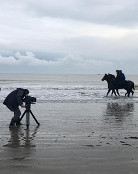Donn's Articles » Weather worries
Weather worries
On Friday morning we were all set for a weekend of top class racing. The card at Naas on Saturday wasn’t bad, there was an interesting novices’ chase with Torphichen and Rahan De Marcigny and Prince Erik, and it would have been worth travelling to see how Solstice Knight would have fared against Shirley Casper on his third run over fences. Sunday’s card at Leopardstown was appetite-whetting stuff, as good a National Hunt card as you could ever hope to find this side of March, Mikael D’Haguenet and Zaidpour and Pride Of Dulcote and Joncol and Cooldine. Then the rains came.
The irony is that there were no problems anticipated. All week the weather forecasters predicted that there would be some rain, but not too much. The advance ground for Naas on Saturday was soft to heavy with no problems envisaged, no inspection planned. On Wednesday the Met Office revised downwards their predicted rainfall for Leopardstown from 20mm to 10mm. With the drying breeze, the talk was of yielding ground on Sunday and the money was for good ground horses.
The rainburst was sharp and full. The racecourses were caught unawares, the Met Office was caught unawares, even Noah himself would have struggled. When Naas manager Tom Ryan fielded a phone call from his foreman at six o’clock on Saturday morning to tell him that the place was flooded, his initial thought was to call a plumber. Some 52mm fell on Naas, 26mm on Leopardstown: only Oxford and Cambridge could have raced.
This weekend was just the latest in a litany of postponements and abandonments that has been one of the features of this National Hunt season so far. Even before this weekend, high-profile postponements were the norm. Punchestown’s John Durkan Chase and Fairyhouse’s Hatton’s Grace Hurdle day were both postponed several times and were eventually staged together at Fairyhouse on 15th December. The Leopardstown and Limerick Christmas Festivals both lost days, while Down Royal was lost, and Thyestes Chase day at Gowran Park was postponed twice before they managed to stage the meeting on a Friday, eight days after the originally scheduled fixture.
On the positive side, there are structures in place now that enable fixtures be postponed as opposed to abandoned. It is good news that Leopardstown’s Hennessy day will be staged in its entirety next weekend. That said, the concertina effect that the re-scheduling has caused is not ideal. Presumably the decision to run the meeting on Saturday instead of Sunday was made in order to avoid a clash with the rugby international. However, as well as clashing now with Totesport Trophy day at Newbury, which probably means that the top UK-based riders will not be able to attend, it has caused a re-shuffling of fixtures involving Gowran Park, Fairyhouse and Navan. Significantly, it means that Gowran’s Red Mills Hurdle – the race that Philip Fenton had ear-marked for Dunguib’s seasonal debut – has been moved back a week to 19th February, which leaves runners in that race with three weeks instead of four weeks to prepare for Cheltenham.
While the re-scheduling of a fixture is good for racing, for the racecourse involved it is a poor consolation prize. It is important for racecourses’ finances that the fixture does go ahead at a later date, if only for the media rights income that they receive from SIS, but history tells us that a re-scheduled fixture doesn’t come close in terms of attendances to dates that are engrained in the racing calendar. Leopardstown’s lost St Stephen’s Day fixture this year was run in its entirety later in the week, but many of the near 20,000 people who make St Stephen’s Day at Leopardstown an annual pilgrimage were lost. In March 2009, such was the marketing campaign that supported the Leinster National meeting at Naas, they were expecting around 4,000 people through the turnstiles before the weather intervened. At the re-scheduled fixture, they barely got 1,600.
The marketing spend is a sunk cost when a meeting is postponed, as are most of the corporate hospitality bookings. You might get some of them to re-book, but generally they are there for the day, not for another day. Printed racecards go into the recycling bin. On top of that, as long as your application to have the meeting re-scheduled is successful, you have the additional staff costs involved in preparing for and staging the new fixture. Direct and indirect costs for even a small racecourse are estimated to be upwards of €15,000.
The worry is that the loss of fixtures appears to be a trend rather than a blip. Winter temperatures are getting lower and winter rainfall is increasing. Punchestown’s experimental use of frost covers last week was a success, given that the uncovered cross-country track was unraceable on the day that they were able to race on the main track, but it remains to be seen if that experiment can be continued, and if the same covers can be effective in the face of lower temperatures.
Hopefully the sun will soon shine.
© The Racing Post, 8th February 2011


 Follow Donn
Follow Donn